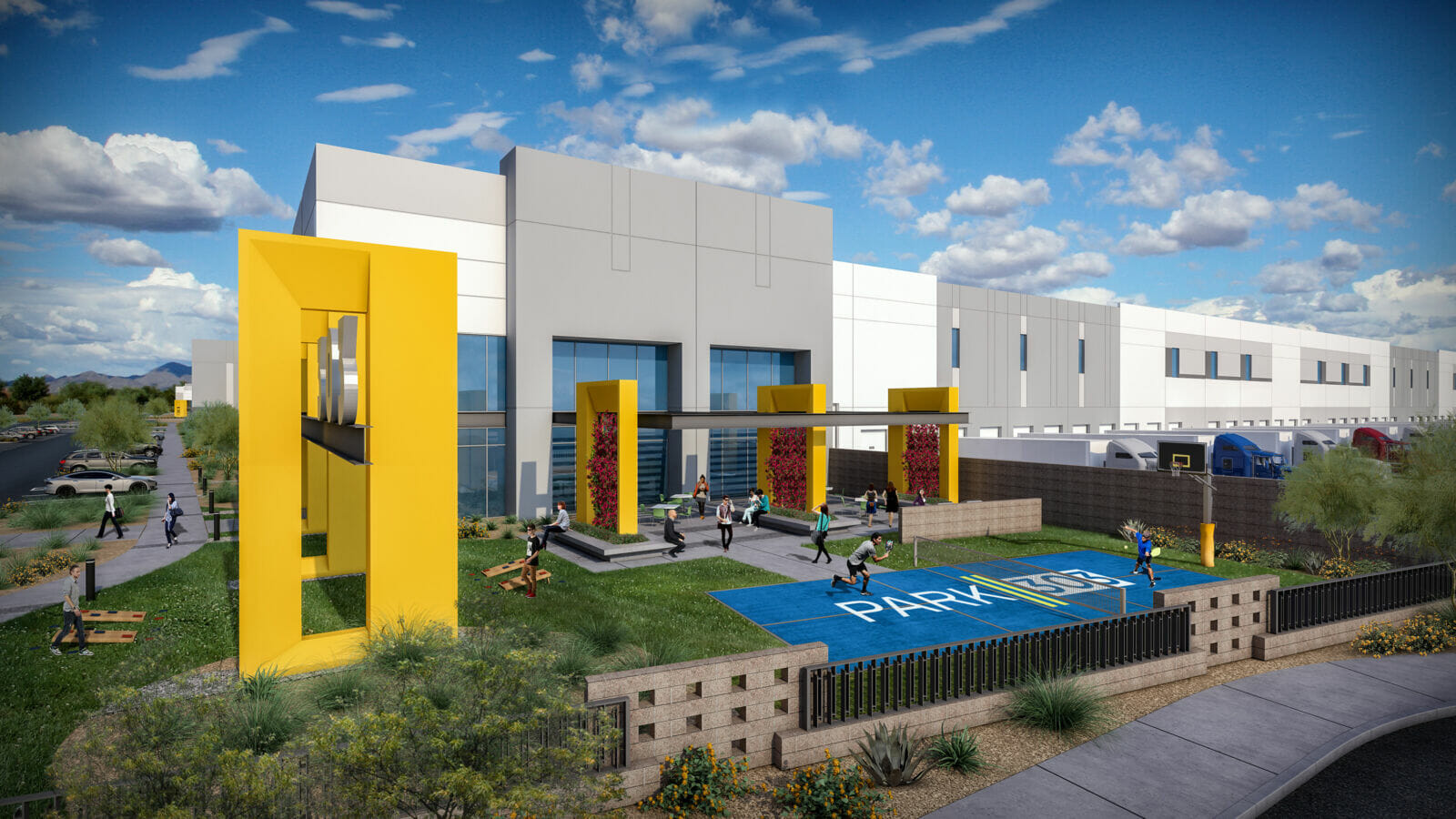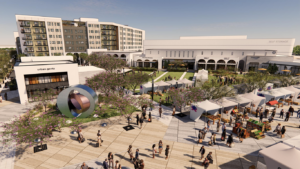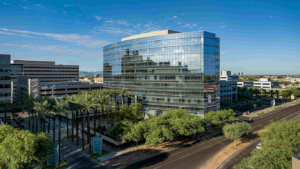It is no shock to know that the West Valley’s industries are booming. Large companies such as Taiwan Semiconductor Manufacturing Company, KORE Energy and countless logistics companies are all making investments as people continue to move to the area rapidly. What will the new West Valley look like with all this development?
Greater Phoenix has attracted labor because of the historically low cost of living, a good job market and eternal sunshine. The development is going beyond a place to commute to work. It is creating a place to work and live.
In Maricopa County, 40% of the residents live in the West Valley, and it is expected to be home to 2.1 million people by 2030.
READ ALSO: Loop 303 corridor becomes global center for development
The median household income is $75,556 in the West Valley, which is $10,000 above the national average. The median home price sits about $10,000 below the national average at $229,579. It also has a strong labor force, with 63% of West Valley residents a part of the workforce age.
Rent growth in the metro area saw 22.5% rent growth well outpacing the rest of the country, according to Thomas LaSalvia, senior economist at Moody Analytics. LaSalvia explains Phoenix is one of 14 out of 82 primary metros that have had employment rates fully recover after the initial decline in March 2020.
Firms in all commercial real estate development sectors — industrial, office and retail — see the advantage that the West Valley has not only in comparison to the state but to the nation.
The construction of Loop 303 certainly opened up new potential to the west by creating easy access to land that was previously cut off from the Phoenix metro. It has acted as a foundation for developing a new section of Metro Phoenix.
WESTMARC President and CEO Sintra Hoffman says, “In the West Valley, we have the talent that lives here locally and nobody wants to drive anymore, especially after the last year and a half.”

West Valley industrial development
The industrial sector is booming, with more than 25 million square feet currently under construction.
“It was a phenomenal year, and markets moved extremely fast in terms of land prices, rental rates and construction cost. Material availability is an issue. 2022 looks great, but it’s definitely moving very, very quickly,” says Steven Schwarz, founding partner of the ViaWest Group.
Material delays are still affecting many markets, with development being no exception. This impacts project delivery dates for current and future complexes.
“I would say the users these days are needing the building sooner rather than later. And we’re now unfortunate to have a delivery of later rather than sooner because of material delays,” says Jeff Foster, vice president and market officer at Prologis. “The silver lining is that having this material delay is putting a little bit of a headwind for us and could be a good thing. So we don’t deliver too much at once, but users need it now. They can’t wait.”
While Metro Phoenix is thought to have endless space to grow, that is not the case. Pat Feeney, executive vice president at CBRE, explains they are working with two site selection companies, and both are classifying Phoenix as a constrained market.
“When you talk to people from out of town, they look at an aerial photo of Phoenix and see there’s land from here to Blythe. But you’ve got to get water, sewer and electricity to it,” Feeney says.
The available, developable land in the West Valley is being snatched up fast.
“We all didn’t realize how spoiled we were when we were going down the 303 and tying up all the sites that had water and sewer. All of a sudden it’s almost impossible to find a site in that corridor. Now at Ryan Companies, we’re looking around the Valley looking where else we can go, and a lot of the options have infrastructure challenges,” says Josh Tracy, vice principal of real estate development at Ryan Companies. “It is going to be years potentially before we can go somewhere and do this much expansion.”
Tony Lydon, managing director at JLL, explains that the metropolitan area of Phoenix is around 400 million square feet, which is small compared with a city like Dallas, which is around 1.3 billion square feet.
“We’re not going there. But we’re going to move from 400 million feet to 600 million feet here in the not too distant future, and that’s just our food group,” Lydon notes. “This is a market where people want to come and live for a lot of reasons.”
With large industrial complexes come jobs that need to be filled.
James Murphy, president and CEO of Willmeng, explains, “Greater Phoenix is going to suck people in from (other areas), which is how it historically addresses supply and demand labor challenges. We’re not generally coaching them to come here. We’re sucking them in with the price point.”
According to the Bureau of Labor Statistics, in Arizona, transportation and material moving occupations makeup 241,750 jobs and construction and extraction occupations make up 137,490. This shows that employment from these manufacturing sites accounts for a good chunk of Arizona’s workforce. This does not include the other roles associated with these facilities.
Another large industry in the West Valley along the I-10 is healthcare. According to Hoffman, 36% of all healthcare workers in Maricopa County live in the West Valley, with 48% of them living and working on the west side.
The freestanding $135 million Phoenix’s Children’s Hospital being built on the Arrowhead campus in Glendale is one example of the strengthening of that industry in the West Valley.
There is development beyond industrial complexes.
Integrating life and business within West Valley development
When touching on the integration of live, work, play, GEN 1, a part of the GSQ project in Goodyear, is a quintessential example. Located on McDowell Road and 150th Drive, the site, with the first stage expected to be finished in June, will include the 125,000-square-foot Goodyear City Hall building, library, three-story Class A office building, with a two-acre park in the center.
The development is also making history, bringing the first-ever parking garage to Goodyear.
Looking forward, the team heading up the project from Globe Corporation and CBRE are talking with a multifamily developer in order to combine a residential aspect to the site. Along with multifamily, retail will be added in the future, as well as potentially another office building to bookend the park.
Just west of the site is Market at Estrella Falls, giving access to retail and dining, and just across 150th Drive to the east sits a Harkins Theater, making the site an ideal place for a city center.
“This is going to be really exciting, and it’s going to really help energize the workforce that is going to be here,” says George Getz, president and co-CEO at Globe Corporation.
The GSQ site also backs up to Bullard Wash Linear Park, which provides not only the aesthetics of a large green open space, but a walkable entrance to the amenities.
The COVID-19 pandemic undoubtedly changed the way we work and what is needed from an office space. In the West Valley, there is only two million square feet of office space. Out of that square footage, there is only 12% vacancy, with most of it being Class B and C office space.
“I think the hybrid model [work from home and office] is here to stay, but I think people need to have an office,” Getz says.
The office building, a part of GSQ, is currently providing office space to the west. He explains that with today’s materials constraints and the rising costs, it may be a while before there are more offices built.
Along with offices, more retail is being added to support the new residents and their needs.
West Valley retail development
Retail development has changed in the recent past. Josh Simon, founder and CEO of Simon CRE says, “indoor malls are dead.” His company completes projects across the nation, and he and his team are seeing how fruitful the Metro Phoenix market is.
Village at Prasada, located on the southeast corner of Waddell Road and Loop 303 in Surprise, is a mixed-use development with phase one, 300,000 square feet, being delivered in Q3 2022. Simon says they are currently at 100% lease or letter of intent for the development.
“The West Valley is hot, and people are seeing that there are people living there and incomes to support it. Also, there’s not really another destination like this center,” Simon explains.
These developments will bring large retailers, smaller boutiques, dining and entertainment to the West Valley.
“People look at West Valley growth and think about Loop 303. One thing I think is really starting to happen is the infill. There are certain areas east of the stadium around 75th Avenue in Glendale where we’re seeing a homebuilder rezoning quite a few acres from industrial to single-family. You’re seeing townhomes being built and more apartments,” Simon says. “A lot of these areas inside Loop 101 will have a lot more attention spent on them, and we’re going to see a lot more growth and redevelopment in that area.”
Another place in the Valley that may be getting some attention in the coming years is the Loop 202 expansion.
The area has constraints, Lydon explains, zoning being one. Schwarz adds that a lot of the growth is beginning within five or so miles of the respective connections to the other highways.
Foster concludes, “I think Phoenix is extremely well-positioned going forward.”




